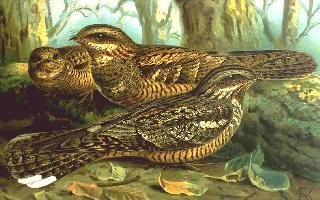
Váhy a míry
| Délka | od 25 do 28 cm |
|---|---|
| Délka rozpětí křídel | od 57 do 64 cm |
Popis zvířete
The European Nightjar (Caprimulgus europaeus) is a fascinating and elusive bird that captivates the interest of birdwatchers and nature enthusiasts across its range. This species is part of the nightjar family, Caprimulgidae, known for their nocturnal habits and unique camouflage. The European Nightjar is widespread throughout Europe, parts of Asia, and in some regions of North Africa. It is a migratory bird, spending its breeding season in temperate regions and wintering in sub-Saharan Africa.Adult European Nightjars measure approximately 25 to 30 centimeters in length, with a wingspan that can reach up to 60 centimeters. Their plumage is a complex pattern of greys, browns, and buffs, which provides excellent camouflage against the forest floor or tree bark, making them incredibly difficult to spot during the day. This cryptic coloration is one of their most distinctive features, along with their flat, wide heads and large, dark eyes, which are well-adapted to their nocturnal lifestyle.
The European Nightjar does not build a nest; instead, it lays its eggs directly on the ground, usually in open woodland, heathland, or moorland. The choice of such habitats is strategic, as it provides them with ample cover from predators and a rich hunting ground for their prey. Their diet consists primarily of moths and other flying insects, which they catch on the wing during their active periods at dusk or dawn, and sometimes throughout the night.
One of the most remarkable aspects of the European Nightjar is its vocalization. The male's song is a sustained, trilling churr that can last for minutes without interruption, a sound that has become synonymous with warm summer nights in their habitat. This call is used to attract females and to establish territories among males. In addition to their vocal calls, they are also known for their silent flight, an adaptation that enables them to sneak up on their prey and avoid detection.
During the breeding season, European Nightjars are solitary and highly territorial. The courtship involves aerial displays by the males, who show off their wing-clapping abilities and acrobatic flight skills to impress potential mates. After mating, the female lays one to two eggs, which she incubates for about two to three weeks. The chicks are born with a fluffy down and are camouflaged to blend into their surroundings, providing them with a first line of defense against predators.
As a species, the European Nightjar faces several threats, including habitat loss due to forestry practices, urbanization, and changes in land use. However, they are adaptable birds and have shown resilience by occupying new habitats, including gravel pits and quarries. Conservation efforts are ongoing to protect their natural habitats and to monitor population trends.
The European Nightjar remains one of the most intriguing birds of the European and Asian continents. Its nocturnal habits, cryptic appearance, and mesmerizing song make it a unique species that continues to fascinate and inspire those who have the chance to encounter it in the wild.
Mapa výskytu

Nové fotografie zvířat
Top 10 zvířat
- Diana monkey (Cercopithecus diana)
- Dolphin gull (Leucophaeus scoresbii)
- Moustached guenon (Cercopithecus cephus)
- Galápagos tortoise (Geochelone nigra complex)
- Colossal squid (Mesonychoteuthis hamiltoni)
- Japanese spider crab (Macrocheira kaempferi)
- Stone loach (Barbatula barbatula)
- Common house mosquito (Culex pipiens)
- Common reed warbler (Acrocephalus scirpaceus)
- Sea urchins (Echinoidea)